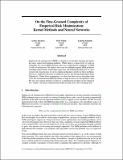Notice
This is not the latest version of this item. The latest version can be found at:https://dspace.mit.edu/handle/1721.1/137640.2
On the fine-grained complexity of empirical risk minimization: Kernel methods and neural networks
| dc.contributor.author | Indyk, Piotr | |
| dc.contributor.author | Schmidt, Ludwig | |
| dc.contributor.author | Backurs, Arturs | |
| dc.date.accessioned | 2021-11-08T13:05:22Z | |
| dc.date.available | 2021-11-08T13:05:22Z | |
| dc.date.issued | 2017 | |
| dc.identifier.uri | https://hdl.handle.net/1721.1/137640 | |
| dc.description.abstract | © 2017 Neural information processing systems foundation. All rights reserved. Empirical risk minimization (ERM) is ubiquitous in machine learning and underlies most supervised learning methods. While there is a large body of work on algorithms for various ERM problems, the exact computational complexity of ERM is still not understood. We address this issue for multiple popular ERM problems including kernel SVMs, kernel ridge regression, and training the final layer of a neural network. In particular, we give conditional hardness results for these problems based on complexity-theoretic assumptions such as the Strong Exponential Time Hypothesis. Under these assumptions, we show that there are no algorithms that solve the aforementioned ERM problems to high accuracy in sub-quadratic time. We also give similar hardness results for computing the gradient of the empirical loss, which is the main computational burden in many non-convex learning tasks. | en_US |
| dc.language.iso | en | |
| dc.relation.isversionof | https://papers.nips.cc/paper/7018-on-the-fine-grained-complexity-of-empirical-risk-minimization-kernel-methods-and-neural-networks | en_US |
| dc.rights | Article is made available in accordance with the publisher's policy and may be subject to US copyright law. Please refer to the publisher's site for terms of use. | en_US |
| dc.source | Neural Information Processing Systems (NIPS) | en_US |
| dc.title | On the fine-grained complexity of empirical risk minimization: Kernel methods and neural networks | en_US |
| dc.type | Article | en_US |
| dc.identifier.citation | Indyk, Piotr, Schmidt, Ludwig and Backurs, Arturs. 2017. "On the fine-grained complexity of empirical risk minimization: Kernel methods and neural networks." | |
| dc.eprint.version | Final published version | en_US |
| dc.type.uri | http://purl.org/eprint/type/ConferencePaper | en_US |
| eprint.status | http://purl.org/eprint/status/NonPeerReviewed | en_US |
| dc.date.updated | 2019-05-31T14:35:34Z | |
| dspace.date.submission | 2019-05-31T14:35:35Z | |
| mit.license | PUBLISHER_POLICY | |
| mit.metadata.status | Authority Work and Publication Information Needed | en_US |
